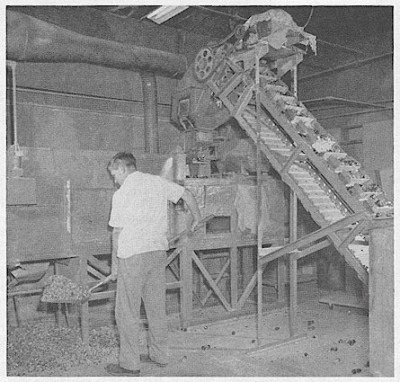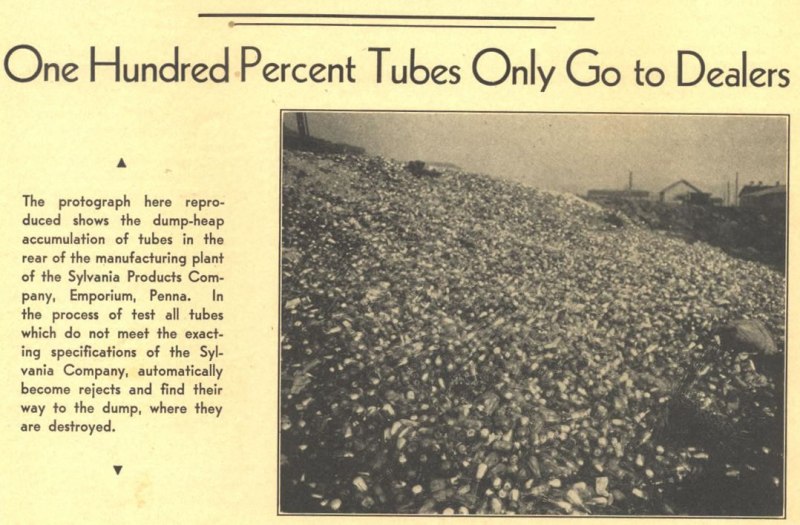This week, we’re switching off the ‘Tube and taking a field trip to Emporium, Pennsylvania, home of the Sylvania vacuum tube manufacturing plant. Now, a lot of companies will tell you that they test every single one of their products, ensuring that only the best product makes it into the hands of John Q. Public. We suspect that few of them actually do this, especially these days. After all, the more reliable the product, the longer it will be before they can sell you a new one.
 For Sylvania, one of the largest tube manufacturers of the golden age, this meant producing a lot of duds. A mountain of them, in fact, as you can see in the picture above. This article from the January 1957 issue of Popular Electronics vilifies forgers who used all kinds of methods to obtain defective tubes. They would then re-brand them and pass them off as new, which was damaging to Sylvania’s good name and reputation.
For Sylvania, one of the largest tube manufacturers of the golden age, this meant producing a lot of duds. A mountain of them, in fact, as you can see in the picture above. This article from the January 1957 issue of Popular Electronics vilifies forgers who used all kinds of methods to obtain defective tubes. They would then re-brand them and pass them off as new, which was damaging to Sylvania’s good name and reputation.
In addition to offering a reward for turning in known tube forgers, Sylvania did the most reasonable thing they could think of to quash the gray market, which was building a tube-crushing machine. Pulverizing the substandard tubes made sure that there were no “factory seconds” available to those fraudsters. After crushing shovelful after shovelful of tubes, the glass splinters were removed through a flotation separation process, and the heavy metals were recovered.
Did we get you all hot about tubes? Here’s how Mullard made their EF80 model.
[Thanks for the tip, Fran!]
Retrotechtacular is a weekly column featuring hacks, technology, and kitsch from ages of yore. Help keep it fresh by sending in your ideas for future installments.
















Wait..Whu? I was looking for the video. I think this is the first retrotechtacular that hasn’t had one.
There’s been a couple. :)
Dangit! There goes my tube reselling business!
Ahh, well, there’s always underpants.
Wow, thanks for the laugh! I’ll let you know when/if I come up with a clever enough response to that one!
And here I was thinking I should have gone with ‘counterfeit jeans ring’.
What about Calvin Klein, Gloria Vanderbilt, and Antoine Bugleboy!?
They’re all there in the car hole.
“We suspect that few of them actually do this, especially these days.”
Absolutely not true. I have seen 55 gallon drums of raw wafers because the dies did no meet spec and I have seen gaylord boxes full of other kinds of produce because they don’t make QA.
Interestingly, the Sylvania company is a long running family business, owned jointly by these delightful fellows:
http://www.mysylvanians.com/skin/frontend/blank/theme039/images/wall-market-1280×960.jpg
Too bad modern tube manufacturers are not as stringent. I have had more new (modern) tubes that were DOA than NOS (new old stock) by far. And the old ones last much longer as well. If a re-issue Fender amp comes in with the original Fender-branded tubes I know they are the first thing to suspect. The Chinese 12AT7 are *always* bad after a couple years while a ’60s RCA is probably still good!
Part of the problem is that current manufacture cannot use the same materials and processes due to cost, environmental regulations, etc. The other part is lack of QC. Some brands are better than others, but I had a DOA JJ 12AX7 today and they’re one of the good guys!
Thank you environmentalists for losing sight of the big picture.
The big picture is that you need your tubes? Seriously?
pretty sure he was making a joke.
The big picture being that one device made by a “dirty” process (or by more lax emission/content regulations) will outlast several devices made by a “clean” process (or more strict regulations), thus not filing the dump.
Same goes for chinese-style cost cutting, one properly made will outlast several cheaper ones, thus being not only more ecological, but also more economical in the long run.
A good, long lasting tube needs a fair bit of rather exotic materials (at least today), some of them considered harmful (and thus not welcome in the western world).
Even with a tightly controlled production process (not likely with a small chinese manufacturer), you will still end up with a fair amount of non-spec tubes that would have been scrapped in the old days, but because of the different mentality, lower volume production and (in case of “brand” tubes) higher unit cost, they try to sell everything.
There isn’t really any info on the crusher itself. For those who want to know a bit more about how different crushers work, take a squizz at the wikipedia article on crushers:
http://en.wikipedia.org/wiki/Crusher#Types_of_crushers
I think jaw crushers are super cool, and I have one on my ever growing to-do list.
My favorite Crusher is Beverly.
Nobody liked the Wesley, it tended to have an annoying whine.
I once did a lighting retrofit, and used about a thousand 4′ flourescent lamps. Exactly one lamp in every box was a dud. It was a remarkable coincidence, probably not a coincidence if you ask me. It was just that one batch on that one job. We get duds now and then, but not one per box. (box is 30 lamps)
“The Sylvania Tube Crusher” – sounds like a Pro Wrestler’s name.
Maybe he can cross over to MMA and fight Fedor.
Why did we ever put up with labels just printed on, especially those water washable inks that were often all that identified a tube. The ID could have been on the inside, let some goon try wipe that off.
Most of the folks I’ve met who are really into tubes could tell the type just from a glance on it – presumably a required skill as those markings rally come off easily. Only difficulty comes when trying to tell a (noval) series 300mA heater type from parallel 6.3V – there hooking up 6.3V between pins 4 and 5 and verifying the glow color can help ;)
I wonder if any of the equality name brand manufacturers ever diverted second that meet lower, but still funtional standards to a “bargain” brand line that sold a at a lower cost.